Malcolm Gladwell is a critically acclaimed author, famed for his work for The New Yorker and his debut book, The Tipping Point.
In his MasterClass, Malcolm Gladwell teaches the art of non-fiction writing (with an emphasis on bringing stories to life). I couldn’t wait to take Gladwell’s MasterClass and learn writing from one of the most renowned authors of our time.
If you’re reading this review, you’re probably wondering how good is the Malcolm Gladwell MasterClass is, whether it has anything to offer you and is worth your time and investment.
This balanced Malcolm Gladwell MasterClass review is here to help you decide. I will be sharing my experience of completing the class in full and detailing the good, the bad and the ugly.
If you just want the headlines or are pushed for time, this summary is for you:
.
Quick summary
Learn how to:
- Structure narrative in an appealing way
- Understand and write for your readers
- Effectively research
- Find and develop an intriguing story
- Get the best out of interviewing subjects
- Capture characters in a convincing way
- Use language to manage your audience
Pros
- Learn from an acclaimed and trustworthy source
- Gain valuable tools to keep your reader engaged
- Benefit from sound advice about breaking into journalism
Cons
- Quite anecdotal
- Strays from the point in places
Course length: 24 lessons totalling 4hr and 54m.
Best for: Anyone interested in a career in journalism or nonfiction writing.
Overall: An insightful MasterClass for those looking to develop their skills in nonfiction/journalistic writing. Malcolm was visibly passionate about what he was teaching and shared some great tips for audience engagement. I left the course with some valuable knowledge and further reading that I was eager to explore.
So now for the finer detail. Here’s what I’ll be covering:
- What’s included in Malcolm Gladwell’s MasterClass.
- What I liked and didn’t like.
- Who the course is for.
- Price, alternatives, and whether the course is unique.
Let’s begin with a brief precis about Malcolm Gladwell and the MasterClass proposition.
About Malcolm Gladwell
Malcolm Gladwell is a Canadian author, journalist, and public speaker. He has been writing for The New Yorker since 1996.
His award-winning works include What the Dog Saw, David and Goliath, and Talking to Strangers.
He is the co-founder of Pushkin Industries – an audio content company that produces podcasts on history and music.
Malcolm has also been included in TIME’s 100 Most Influential People list.
If you haven't seen the trailer for Gladwell's class, I highly recommend you watch it:
About MasterClass
“Our instructors are the best in the world.”
MasterClass is an online educational resource founded in 2015. It offers over 80 video courses from celebrities who have achieved global acclaim for their art, including Gordon Ramsay, Judy Blume, and David Lynch.
With names like these hosting their classes, it’s no surprise that MasterClass has gained its high status.
However, MasterClass might not be for everyone. While its high production quality is a plus, there may be some drawbacks worth considering before committing to a course.
If you want more detail on MasterClass and some of its most popular classes check out our Masterclass review and best MasterClass article.
Inside Malcolm Gladwell’s MasterClass
Malcolm’s MasterClass has 24 lessons between 10 and 20 minutes long. This adds up to around 6 hours of video content.
There is also a class Workbook that can be studied alongside/apart from the videos.
Here’s a play by play breakdown of the lessons so you can decide if this is the right course for you.
Lesson 1 and 2: Introduction and Structuring Narrative
“One thing I want you to take away from this class is the idea of writing as a calling.”
Malcolm opens with an introduction to his first ever online class. He gives a brief overview of his career, and shares some tidbits of where he gets his ideas. This was a nice insight into what he would elaborate on throughout the course.
His main focus here is narrative structure, which he compares to puzzle-solving with our job being to decide where the pieces fit. At this early point, he’s already created an interesting frame for how we can view the concept of storytelling.
He provides great advice about how to create a more intriguing puzzle, pique a reader’s interest and leave them with an “aftertaste.” He poses the question, “What is interesting?” and spends a good portion of the lesson exploring this.
Malcolm uses a lot of case studies to illustrate his theories and also uses storytelling as a method of teaching. This gave the course a meta-like quality, and was a helpful way of teaching by example.

Lessons 3 and 4: Holding Readers
“Your job as a writer is to create an environment where stories can be told.”
Here, Malcolm offers some useful guidance when it comes to drawing a reader in. He stresses the importance of offering a framework for readers and delves into the following:
- How readers think
- The provision of “tools” to guide your reader
- How data can enhance a reader’s experience of your story
- The use of “candy” within narratives
- Distinctions between talking and thinking
MasterClass breaks this section down into two sub-categories:
- Tools for Engagement
- Controlling Information
In both, Malcolm sheds light on our job as a writer and how to cultivate surprise to keep a reader fixed.
Overall, this section was in-depth and eye-opening. Malcolm does a great job of positing an idea and elaborating on it to clarify its usefulness.
With his journalistic background, Malcolm also succeeds in sharing with us the science of human experience. He qualifies a lot of insights with psychology, including how we interpret emotions and what narratives mean .
All in all, this does an excellent job of contextualising the goals of nonfiction writing. All of Malcolm’s advice is useful for highlighting how best to share stories.
Lesson 5: Research
“The central challenge you have as a writer is the challenge you have at the beginning.”
In this section, Malcolm shares his fluid approach to research. Namely, he emphasises the importance of researching with an open mind. He also deters us from the kinds of research that drive us into a corner.
Throughout the video, Malcolm outlines the distinctions between different sources and highlights their pitfalls. This was valuable for its insights into the research process. Mainly, it showed us how to make the most of research by starting with an open mind.
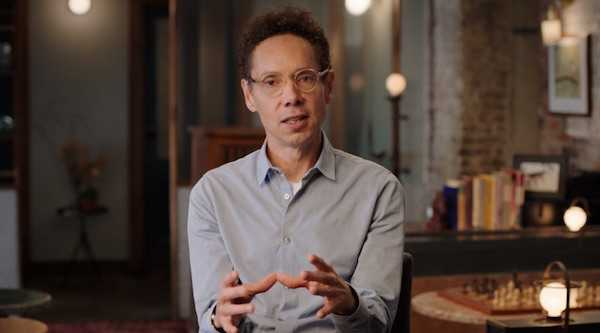
There’s a lot of useful information about compiling articles and tracing lines of interest. Like his other videos, this section also gives us case studies so we can better understand how good research shows on the page.
Malcolm shares with us some of his favourite writers, and breaks down their strengths as researchers. This was a nice way of helping us to read others’ works critically to see how good research pays off.
Lesson 6: Selecting the Story
“I think all good stories have one thing in common.”
Malcolm anchors this topic with an anecdote about a criminologist. He discusses the ways in which this encounter helped him to arrive at a new idea for a story.
Specifically, Malcolm teaches us about the “principle of connectedness” and how we can use this as a starting point.
This section covered a lot of information about how to find and build a story, and Malcolm gives examples from his books. He also gives us some ideas about where to start, and what techniques to use to explore an idea further.
I liked that he gave us some critical starting points from which to consider an idea and tackled what he calls “the first-person problem.”
Lesson 7 & 8: Developing the Story
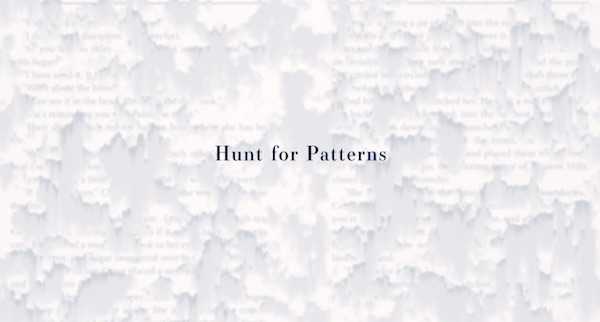
Malcolm continues with further insight into how to take and grow an idea. He stresses the importance of testing ideas and outlines some of the ways we can do this.
His advice has a good balance of solid teaching and more philosophical examples. I found this to be a practical teaching method, as it left some work to the reader to draw conclusions from his anecdotes.
Malcolm also spends some time discussing patterns in stories and compares this to the workings of human memory. Unlike the creative writing courses I had taken, this seemed to have a much more scientific approach and offered a new way of looking at the storytelling process.
Lesson 9: Interviewing
“Running an interview when you’re tired is a waste of time.”
Of all Malcolm’s lessons, this seemed to be the least anecdotal and the most concrete. Interviewing is clearly a key part of what Malcolm does and I feel that it was here that he gave some of his best advice.
While being open about his own weaknesses as a journalist, he advises us on how to get the best out of an interview, with attention to the following:
- Your job as an interviewer
- Types of interviews and their pros and cons
- What you need to know as an interviewer
- How to make your subject feel at ease
- Managing an effective interview
This section gives us some super helpful tactics for interviewing, whether we’re completely new to it or have some experience. He considers the types of questions we should be asking and why some interviews succeed while others don’t.
Malcolm clearly highlights our job as an interviewer, contrasting our role to those of late night talk shows, and concludes by reframing the ways in which we should consider our weaknesses (and how to get help for them).
Lessons 10-12: Characters
Malcolm dedicates 3 chapters to characters, and immediately distinguishes between nonfiction and fiction characters. He provides tips on how to capture a character’s essence and translate it onto the page, whilst doing justice to the (sometimes living) person.
I liked that Malcolm gave some layers to the concept of character. He goes beyond telling us how to describe someone and instead ventures into the territories of character relationships, narrative function, and world-building.
He reads extracts of his character descriptions and takes us through the tactics he uses in each one. This was a good way to back up his points and it was helpful to see his advice in practice.

He guides us through some helpful writing tasks, teaches us how to profile characters and shows us how we can do this for ourselves.
Lesson 13 & 14: Language and Jargon
“My goal is to write at an eighth grade level, but with super sophisticated ideas.”
Here Malcolm shares with us one of his favourite pieces of writing and what struck him most about it. He tells us that writing doesn’t have to be complicated, and that the clearer the writing, the better the outreach.
In fact, he spends a lot of time discussing how to let a reader in rather than shut them out, and teaches us how to use language effectively to impact the reader. He also shows us how to:
- Play with sentence structure for effect
- Use form to create emotion
- Establish rhythm with punctuation
- Use jargon as shorthand
- Cultivate suspense through language
As his lessons become more technical, he relies a lot more on excerpts from his work to cement his key points. This was a helpful way of seeing what different techniques can achieve and how to tailor your writing to guide your reader.
Along with textual excerpts, Malcolm also draws upon public speaking as a way to assess a room and learn to be attentive to your reader. I liked that he showed us how public speaking can help us with our writing, as it was a refreshing approach that I hadn’t considered.
Lesson 15: Tone and Voice
“Your writing style is an instrument that needs to be honed and trained.”
From the offset, Malcolm dissuades us from certain techniques that he sees as bad writing. He then suggests how to manage our audience with tone. He compares this to the Q&A section at speaking events, and suggests how writing can be both similar and different.

Malcolm also gives an example of how he begins a chapter in David and Goliath, and how he worked to set an intentional tone from the beginning. He tells us what he is trying to get across in these opening paragraphs and how to use the opening to set tone, scene, and character.
Along with this, he sets further writing tasks to encourage us to move between forms. This, he says, is a key way of re-envisioning your writing, and testifies to the symbiosis of tone and form.
Lesson 16 & 17: Humor and Melancholy
“Humor is merely a pleasant deviation from an expectation.”
In this lesson Malcolm focuses on the concepts of humor and melancholy to show us how to provoke deep emotion in our writing. He also discusses the sensitivity of writing sadness and how to keep this as authentic as possible.
Coupled with this, he also teaches us how to use humor effectively and how to create a context in which responses are easily produced rather than forced.
There are some great tips on how to set and manage readers’ expectations, and suggestions for ways in which we can keep our humor tasteful and avoid falling into the trap of “trying too hard.”
Malcolm frames this chapter as an inside look into how to invoke emotions, which, for many, is an essential part of reading and engaging with a piece of writing.
He ends this section with a case study of his article “Something Borrowed” (published in The New Yorker here).
As well as showing us how he creates emotion in this piece, he also draws our attention to the following:
- How he brings characters to life
- What he wants to avoid when writing
- How to compensate for weaknesses in writing
- The importance of setting
- How to create appeal through vulnerability
Malcolm uses “Something Borrowed” to illustrate how he achieves all these things as well as to exemplify how he tried to do justice to a sensitive subject. He tells us exactly what he wanted this work to achieve and how he did it.
Lesson 18: Titles
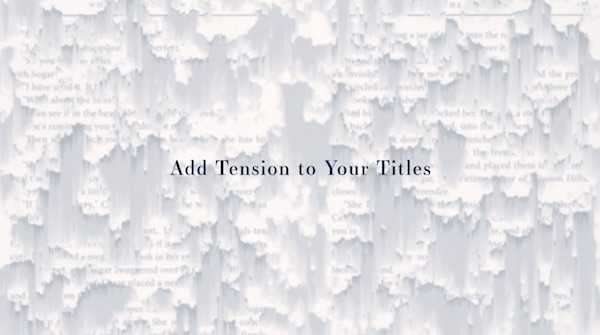
“I’m fascinated by the notion of capturing someone’s attention, and that’s what a title is.”
Unlike other writing courses I had taken, Malcolm dedicates an entire chapter to titles. He tells us why he chose some of his famous titles: Outliers, The Tipping Point, Blink, and What the Dog Saw.
He stresses the importance of titles for grabbing the reader and discusses the reader’s thought process when they’re looking for a new book.
In particular, he emphasises the following points:
- What makes an effective and memorable title
- Creating tension in your title
- Using titles to provoke a reaction
- Embedding emotion into titles
For some, the title of the book might not be that important. But, for Malcolm, it’s a key selling point and part of the book’s advertising strategy. He gives some examples of effective titles and the messages they send to readers.
Lesson 19: Drafts and Revisions
“You have to accept the fact that your first couple of drafts are going to be bad.”
Towards the end of the course, Malcolm discusses how to draft and revise your work effectively. Specifically, he teaches us how to do the following:
- Reframe how we view productivity
- Organise your daily writing
- Draft and revise your work
- Manage your expectations as a writer
- Balance writing with research
- Edit in reverse
Malcolm brings together a lot of his previous discussions of suspense and humor to bear on the editing process. He shows us how to keep the reader in mind when approaching drafts and even suggests where to start to get the most out of revising.
A lot of Malcolm’s advice involves managing narrative information for the best impact and also how to write for rather than against the reader. He addresses our concerns about writers’ block and offers ways in which we could rethink this obstacle.
I find it useful to gain this sort of insight into writers’ minds, as I alway walk away with something new and useful. In particular, Malcolm does a good job of helping us gain perspective when editing and outlines the difference between simple and complex revision.
Lesson 20: When Your Story Enters the World
“Once you’ve written something, it no longer belongs to you. It belongs to your readers.”
Following on from his editing perspective, Malcolm shares some helpful knowledge on the transfer of agency post-publishing. This is especially helpful for managing the critical side of writing, and suggests some ways in which we can view the relationship between writer and critic.
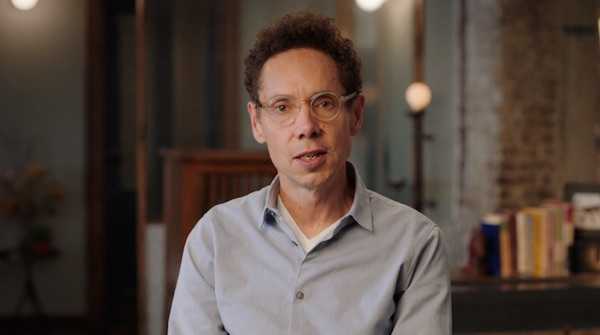
Malcolm gives us an example of some backlash he received when writing about “the 10,000-hour rule” and demonstrates the inevitability of readers re-interpreting our work.
This advice was more geared towards those further along in their writing careers, from at least after the publishing stage.
Nonetheless, this was an interesting way of seeing how writing related to the outside world and the degree of control you lose as an author.
Lesson 21: Working as a Writer
“What can I do to make sure that I’m different from everyone I’m competing with?”
Here, Malcolm discusses how to best approach your career as a writer. He tells us what helped him to stand out and how we can draw on our differences to appeal to readers.
I liked how open and authentic he was in this section, as he discussed his difficulties breaking into the world of journalism and how he navigated his weaknesses to get started.
In fact, Malcolm gives us some practical advice on how to get into writing as a career. While he’s honest about the hardships of writing, he does show us how he achieved his goals by working around the realities of his daily life.
Although he shared his experiences, this section was a lot less anecdotal and more concrete when it came to giving us ways in which we can really get ahead in our careers.
Lessons 22-23 Reading: How and Who
“Reading is of equal importance to writing.”
As Malcolm sees it, writing and reading are inseparable skills – one cannot exist without the other. Malcolm tells us how we can best approach reading to get the most out of it on a deeper level.
He also teaches us what to look out for when approaching a text and suggests how this can help us to become better writers ourselves.
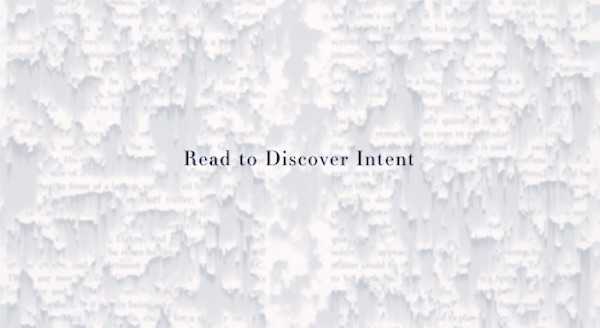
Malcolm dispels a lot of myths about the role of a critic and shows us how we can approach work in both a critical and appreciative way. He tells us which kinds of writing will stay with us, and how we can achieve this in our work.
Again, he gives us a writing exercise, which he believes can help us better understand other writers.
I was most excited about hearing some of Malcolm’s favourite authors and why he likes their work so much. We learn about the books that fascinate him as a reader and how they relate to his previous points about puzzle-solving and high-quality research.
Malcolm ends by sharing his own anxieties as a writer and suggests ways in which we can work through our shortcomings. He also tells us how he improved his writing over time and how he read critically to arrive at where he is today.
Lesson 24: Conclusion: A Theory of Other Minds
“Writing is an act of service.”
Malcolm ends his course by telling us about the “other minds” problem. This is a psychological theory of child development that Malcolm sees as a crucial way of understanding and creating stories.
He teaches us the following:
- How the “other minds” theory pertains to writing
- What draws us to a story
- How writing differs to other art mediums
- The ways in which we can represent other minds to the world
By the end of the video, Malcolm has shared with us why we gain so much pleasure from reading. He supports his ideas with scientific evidence and even shares a few more extracts from his book, What the Dog Saw.
This was an interesting way to finish the course and left me with even more food for thought. He stresses the importance of inhabiting other minds and the opportunity it gives to share with readers new worlds.
My Experience of Malcolm Gladwell’s MasterClass
Overall, there was a lot I liked about Malcolm’s class. I will highlight these points below.
However, I also don’t think this course is for everyone so I’ll be listing a few areas in which I felt it could be improved.
It’s worth considering both the pros and cons before deciding whether this course is right for you.
What I Liked
Learn from a Reliable Source
Knowing Malcolm Gladwell’s achievements as an author and journalist, I felt sure I’d be learning from the best. As the News & Observer praised, “He might be the best storyteller on the planet.” In this MasterClass, we get to learn directly from Malcolm himself.
MasterClass is known for its high production values, and Malcolm’s course is well-organised into excellent-quality video lessons. Malcolm has a clear style of delivery and a refreshing take on storytelling.
I liked that Malcolm used anecdotes and case studies to concretise his theories and felt that he had a good grasp of reading and writing from a psychological perspective.
Give Your Readers Tools
While a lot of writing courses on MasterClass discuss giving writers “tools,” Malcolm discusses the tools we should be providing to our readers to better guide them through our world.
I particularly liked that Malcolm discussed jargon and suggested the ways in which it can invite a reader in rather than shut them out.
Malcolm teaches us how to set context for our readers and give nuggets of information to help them navigate our work. He helps us to understand the following:
- Connecting readers to data
- Giving readers candy vs. a meal
- Using in-text references to create points of interest
- Making writing memorable
It was also interesting how Malcolm used storytelling as a teaching method. This added another layer to the video lessons and, in a sense, led by example.
Find and Develop a Story
From my experience on MasterClass, I’ve found that a lot of users (myself included) struggle with managing ideas. Malcolm’s course differs slightly from creative writing courses because it specialises in non-fiction, which Malcolm suggests has its own rules and structures when it comes to creating a story.
Malcolm provides examples of where to look for story ideas and shows us how to “test” an idea before developing it further. He also has some great advice on how to gain feedback before starting and on what makes a compelling point for research.
A lot of this tied in with Malcolm’s discussions of research and provided us with some sound wisdom on how we, as humans, build and develop stories in our minds. This is insightful for figuring out how to effectively tell a story that will grip your reader.
Interview Effectively
Malcolm dedicates a chapter to interviewing as a way to teach us a new skill and to also inform our writing. As a journalist, he stresses that interviewing is a key part of the storytelling process and it’s down to us to foster an authentic atmosphere for ourselves and our subjects.
He also draws attention to the limitations of interviewing and suggests some ways in which we can make interviews more fruitful. As a mode that’s often personal and sometimes challenging, Malcolm offers some tactics for dealing with the interviewing process and supports his ideas with some examples of successful/unsuccessful interviews.
Overall, this section is incredibly helpful for non-fiction writers who are particularly keen on the journalistic route, and it provides some good insight into how to find and ask the most “interesting” questions for your writing.
Summon a Character’s Spirit
One of the key distinctions between Malcolm’s class and other writing courses on MasterClass is the emphasis on translating a real figure onto the page. While Malcolm doesn’t compare this to fiction-writing specifically, he does show us the ways in which these characters differ.
This section is useful for anyone struggling to describe characters in nonfiction writing, and Malcolm gives us a mixture of pragmatic advice and illustrative examples to help us understand our job as a writer.
Similarly to creative writing, however, he does give us a range of options for rendering character and shows us how we can play with techniques to create different effects.
Use Language to Affect Your Reader
As Malcolm suggests, language can achieve a lot when it comes to presenting or enhancing a story. He draws particular attention to the kinds of language he invokes and what he sets out to achieve when using it.
He also has a fresh approach to editing, emphasising some points I didn’t think of before, such as the musicality of language and ease of access. Malcolm seeks to strike a balance between the simple and the complex, and this led to some valuable insights into how language can speak to its readers.
Good Balance of Theory and Practice
While Malcolm’s lessons are heavy on anecdotes, I think he manages to balance his teaching with a mixture of theory and practical knowledge. His delivery style is informal and he draws our attention to key points with examples from his work.
He compares his work to that of other mediums, including sports-writing and humor sections in magazines. I liked that he gave us some context beyond his own style of writing and showed how it existed in the wider world.
A lot of his chapters are followed by short (or sometimes lengthy) case studies, where he focuses on one key text to illustrate how he used the techniques from the previous lesson.
As most users confirmed, this was an insightful way to learn, and, by telling stories, Malcolm also helped these lessons to stick.
"Gladwell is such an awesome storyteller! Even his CLASS is fascinating!!" - Comment from the community
What Could Be Improved
While I enjoyed Malcolm’s MasterClass and have taken a lot away from it, I don’t think this course is 100% perfect. Here are some points for improvement that are worth taking into account before committing to the course.
Straying from the point
For the most part, Malcolm is easy to follow and his enthusiasm for stories captivate the viewer. At times, he does seem to talk quite quickly and while this wasn’t a huge concern, I did find myself having to rewind at several points because I missed something interesting.
Perhaps because of his excitement when sharing stories, Malcolm did go on a few tangents throughout the course. One user noted that he often starts a point and loses track of his sentence, which can be distracting at times.
"“The author might be very good, but he is a not a very good speaker. He has so many unfinished sentences and unaccountable filler words” - Comment from the community
As well as using a lot of filler words, I felt at times that Malcolm was a bit too heavy on the anecdotes. They often tied in nicely with the video content but could also deter from the main points.
If a few of these were taken out, and the course focused more on his isolated case studies and relevant examples, I think this would’ve reduced the course time considerably and made it easier to watch.
No 1-1 Interaction
One confusing part about Malcolm’s course is the project given at the end of the Workbook. Some users were confused about whether this was a formal assessment and whether they could gain any feedback or clarity on this from Malcolm or MasterClass.
While Malcolm’s course has a community hub, there aren't a great deal of post-lesson updates to address users’ queries. This was a shame as I think a lot of us would’ve found it helpful to have a bit more guidance on the offline exercises.
Nonetheless, I liked that Malcolm encouraged us to send our writing to each other over an “email exchange.” This was something I hadn’t seen on other courses and it took the lessons beyond the comments and the community hub.
It’s Difficult to Pay Attention Throughout
Because of the course length, I found it very difficult to stay enthralled across every single lesson. I think this was partly due to how long each video was, but also because there were so many topics covered that some would naturally appeal less than others.
"I started with a notepad and ended up washing the dishes as I was listening to this." - Comment from the community
Despite being subjective and user-dependent, I do think this MasterClass would have benefited from shorter lessons to help us better digest information. As I mentioned earlier, a lot of anecdotes could have been cut to leave us with the real meat of Malcolm’s lessons.
Controversial Approach to Journalism
Like all courses on MasterClass, Malcolm’s course is one person’s opinion and experience of what works well and what doesn’t. This subjective nature is pretty clear going into the course, and it’s worth understanding that Malcolm will tell you a lot about what works for him and what he considers to be good journalism.
Malcolm certainly has a lot of years under his belt, and most users found his lessons useful. At the same time, there were some who weren’t sure if they agreed with Malcolm’s points as a writer/researcher.
"Ugh Gladwell's a beautiful writer, but he's one of the worst researchers I've ever read. Cherrypicks data, relies upon anecdotes, misinterprets studies and statistics, over generalizes, works backwards from "interesting" conclusions." - Comment from YoutTube
While a lot of criticism came from those outside of MasterClass, there was the occasional disagreement with some of Malcolm’s statements on MasterClass itself.
These were very infrequent, but seemed to leave an impression upon the viewer. With Malcolm telling a lot of stories about his journalistic career, some topics were controversial and perhaps “politically-incorrect.”
Malcolm discusses some touchy subjects (particularly with his interest in crime) and these sometimes divided readers.
For the most part, I think Malcolm did his best to use these discussions to further our learning, but with such polarising topics, his wording can sometimes come across as clumsy.
Who is this course for?
MasterClass lists this course as “Malcolm Gladwell Teaches Writing.” While many of us know his work, some of us might be confused as to what kind of writing we’ll be learning.
Specifically, Malcolm focuses on journalism and other non-fiction writing, dedicating some sections to interviewing and public speaking.
This course is geared towards those interested in a career in journalism, with its parting chapters discussing the process of getting a foot in the door and writing as a career.
I think this course provides not only honest information into the realities of journalism, but also a unique perspective on what this kind of writing can achieve.
If you take this course, you will learn how to do the following:
- Structure narrative in an appealing way
- Understand and write for your readers
- Effectively research
- Find and develop an intriguing story
- Get the best out of interviewing subjects
- Capture characters in a convincing way
- Use language to manage your audience
On a scale of 1-10 (1 being a beginner and 10 being a professional), I think Malcolm’s course is most helpful for those between 1-5. This is because of the strong focus on breaking into journalism and getting started as a writer.
How much does the course cost?
Currently, MasterClass has three subscription offers. The price for these (per month) are:
- Individual (1 user): $10
- Duo (2 users): $15
- Family (6 users): $20
All are billed annually, which may seem a little pricey at first glance.
That being said, the value for money comes from taking as many courses as possible.
With 200+ courses on MasterClass, you’re bound to find many that interest you. But, even if you find that only 10% of the courses interest you, this still works out at $6 per course.
And, if you join with friends or family, the cost for each course is drastically reduced. Check out our MasterClass review or MasterClass cost articles to see how.
Bearing in mind that these courses are taught by leading experts, the value for money is unbeatable. Elsewhere, you can pay over $100 for a course taught by someone you’ve never heard of, and it would nowhere near match the caliber of teaching on MasterClass.
Besides, MasterClass offers a 30-day refund policy if you’re not happy with your purchase.
You can also purchase MasterClass as a gift.
Alternatives to Gladwell’s MasterClass
If you’re not sure whether Malcolm’s course is for you, MasterClass has plenty of other writing courses available:
- David Mamet—Dramatic Writing
- Neil Gaiman—The Art of Storytelling
- R. L. Stine—Creative Writing for Young Audiences
- Margaret Atwood—Creative Writing
- Amanda Gorman — Poetry
- Judy Blume—Writing
- David Sedaris—Storytelling and Humor
- Joyce Carol Oates—The Art of the Short Story
- David Baldacci—Mystery and Thriller Writing
- Billy Collins—Reading and Writing Poetry
- James Patterson—Writing
- Walter Mosley – Fiction and Storytelling
- Salman Rushdie – Storytelling and Writing
- N. K. Jemisin – Fantasy and Science Fiction
A MasterClass subscription gives you access to all the classes so you can take the best from each literary giant.
Outside of MasterClass, there are other options available. There a range of writing classes on Udemy and Skillshare. Some of these are great value for money, but remember, the teachers will not be of the same calibre as Gladwell.
If you are looking for something more academic with certification there are lots of courses on Coursera and edX. The pricing structure for these platforms is a little complex but, generally, you can audit courses for free but you need to pay for certification. These courses are delivered by university academics.
Malcolm Gladwell’s MasterClass: What Others Have Said
Many users came to Malcolm’s MasterClass already big fans of his writing. Because of this, most users were excited about the course. The comments under the videos attest to its overall success.
"I love the way Malcolm writes books that alter who you are as a person when you read them. I am very excited for this course." "This is an amazing MasterClass. I have learned so much. I watched the course twice because there is always something that I missed the first time." - Comments from the community
As mentioned previously, some users had their own conflicts with Malcolm’s style of teaching. At times, users were unclear of how to follow an idea through and found his lessons quite esoteric.
On Reddit, the comments were largely positive, with those taking the course confirming its usefulness for all writers.
"I took the Malcolm Gladwell MasterClass. It was fantastic. Every 10-12 minute segment (25 of them) has juicy tidbits of wisdom." - Comment from Reddit
How long it took to complete the course
With its hefty theory and lengthy viewing time, I think it’s worth taking Malcolm’s MasterClass slowly. There are many anecdotes that can get lost in translation when you’re working through them quickly.
Malcolm’s course can easily be spread throughout a week. Most chapters are categorised easily enough that you can decide which ones to watch in one viewing time.
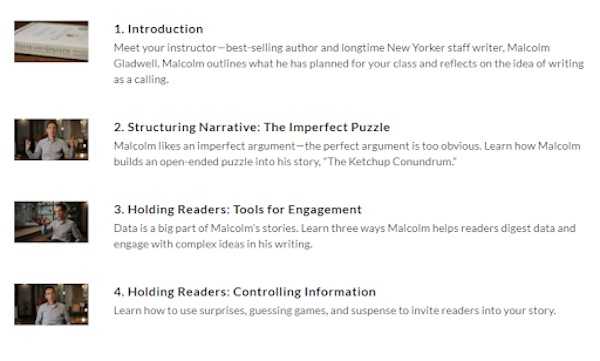
The Workbook is helpful to come back to after lessons and can be useful for putting Malcolm’s ideas into practice. I think the PDF takes longer to get through, mostly because it’s more text-heavy and directs you to further reading.
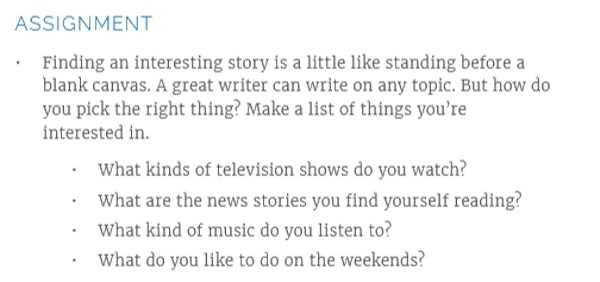
I liked that the Workbook could be viewed as a standalone piece. This meant I could toggle between the two as and when I wanted and work through the course at my own pace.
Is the content unique?
As Malcolm’s only online course, I think the contents of this MasterClass are mostly unique. He takes some familiar examples from his books but also analyses them with us to help us see how he wrote them.
Malcolm definitely teaches us a lot in his books, but this was the first time I understood how he uses stories to teach.
That being said, Malcolm does feature in a video for The New Yorker discusses some of his approaches to storytelling. At 17 minutes, this is quite a substantial insight. However, I still don’t think it compares to the depth he goes into in his 6-hour MasterClass.
Another benefit of the MasterClass is that all of Malcolm’s topics are organised into one clear and detailed course. You have all of the information in one place and Malcolm takes you seamlessly through the idea process to publication.
Most users agreed that this course was insightful and that they took away from it something new.
"Never stops being insightful and logical. Very interesting point about writing in different formats." - Comment from the community
What You Will Need
Malcolm’s MasterClass doesn’t require any additional tools save for a pen and paper or a word processing app. For the further reading, you may need subscriptions to access some articles. Although, MasterClass does its best to offer you as much free content as possible in its Workbook.

Malcolm Gladwell MasterClass: is it worth it?
As someone more interested in creative writing, this wasn’t my favourite course. However, if non fiction is more of interest, this is likely to be a beneficial course for you.
Malcolm gives a lot of advice on breaking into journalism, but he also shares a lot of insights that are helpful for all.
If you’re more interested in fiction, there are many other MasterClasses available. For example, Margaret Atwood teaches Creative Writing, and Neil Gaiman focuses on storytelling in novels and short stories.
I don’t think it’s essential to read Malcolm’s books to understand the course content. Malcolm tells a lot of stories across his videos. So, it’s not quite the same as needing to understand a lengthy novel.
You can access his work online or in the Workbook, Also, his website offers a look into his books if you’re deciding whether to read more of his work.
Overall, I think Malcolm’s MasterClass is hugely insightful for those looking to develop their skills in nonfiction/journalistic writing. I liked that Malcolm was visibly passionate about what he was teaching. He also let us in on his own theories regarding audience engagement. I left the course with some valuable knowledge and further reading that I was eager to explore.
Related articles: Best online writing classes
Frequently Asked Questions
A MasterClass all-access-pass costs $120 a year ($10 a month). This gives you access to this MasterClass, alongside 200+ other courses.
24 lessons totalling 4 hours and 54 minutes.
Unfortunately you cannot get the course for free. But you can sample Gladwell's MasterClass for free and MasterClass has a range of purchasing options and offers refunds if you’re not happy.
MasterClass offers a 30 day refund policy. If you purchased the class from a different provider, their own returns policy may apply.

Rebecca graduated from King's College university with a first class honours in English Language, followed by a Masters' Degree in Eighteenth Century Studies.



I know this if off topic but I’m looking into starting my own blog and was wondering what all is needed to get setup? I’m assuming having a blog like yours would cost a pretty penny? I’m not very internet savvy so I’m not 100 certain. Any suggestions or advice would be greatly appreciated. Appreciate it
Thanks for reaching out! 😊 Starting a blog doesn’t have to be expensive—there are plenty of budget-friendly options. If you’re new to blogging, platforms like WordPress.com, Blogger, or Wix offer free and paid plans that are easy to set up. If you want full control, a self-hosted WordPress.org site is a great option, but you’ll need a domain name and web hosting (SiteGround, Bluehost, or Namecheap are popular choices).
No need to be super tech-savvy—many platforms have beginner-friendly tools to help you along the way. Let me know if you need any recommendations—I’d be happy to help!